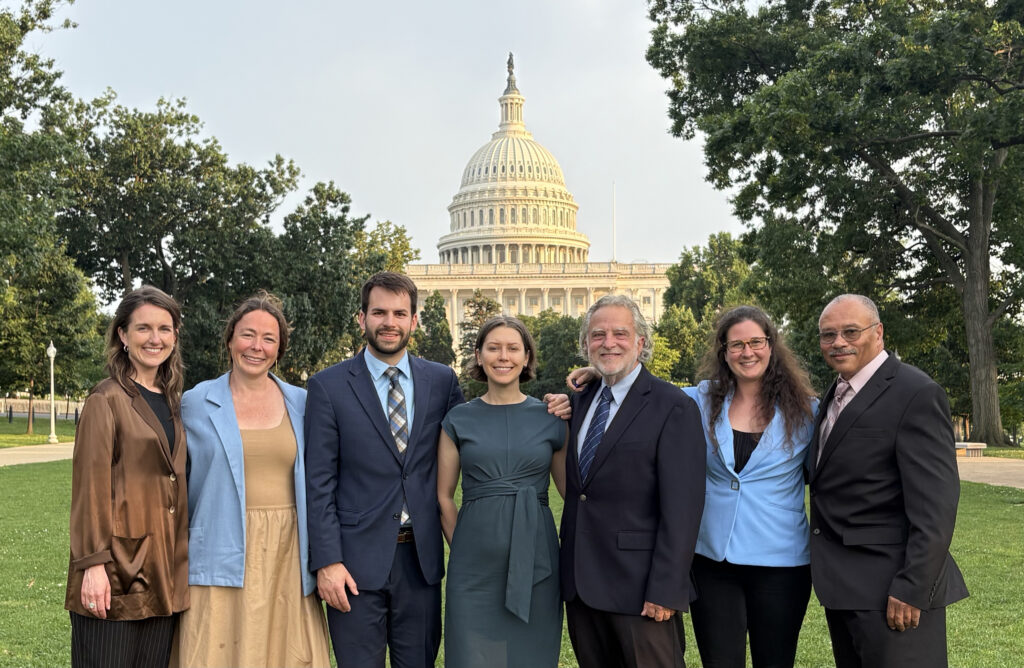Task Force Report for White House Conference on Hunger, Nutrition, and Health
Earlier this week the Task Force on Hunger, Nutrition, and Health released a report to advance the goals of the White House Conference, scheduled for September. The report was led by the Chicago Council on Global Affairs, Food Systems for the Future, Tufts University, and World Central Kitchen. Former USDA Secretary Dan Glickman and former Republican Senate Majority Leader Bill Frist serve as co-chairs.
The upcoming Conference is an historic opportunity to address a key cause of our current public health crisis: the policy foundations of the system that produces our food. Farm Action submitted policy recommendations and attended several events to guide this report and Conference. We’re pleased to see many of our recommendations were included.
Farm Action’s Recommendations in the Task Force Report
Policy Recommendation #3:
Increase nutrition security by promoting dietary patterns that align with the latest Dietary Guidelines for Americans (DGA) through federal nutrition programs.
This section focuses on using government resources to realign dietary patterns with DGA recommendations. Part of their recommendations include creating a nationwide produce incentive program for all SNAP participants by fully funding the Gus Schumacher Nutrition Incentive Program (GusNIP) Produce Prescription Grant Program so that it can support all SNAP participants throughout the year, as we highlighted in our recommendations.
Policy Recommendation #5:
Leverage the federal nutrition programs’ power in economic stimulus to support food systems that promote foods that align with the latest DGA.
This policy recommendation would direct the USDA to use its purchasing power to encourage the development of local and regional food systems. The report includes six specific actions, most of which come right out of Farm Action’s White House Conference recommendations and Farm Bill Handbook.
Actions include:
- Eliminating the lowest bid requirement in food procurement regulations for schools and replacing them with a value-based approach. The evaluation metric would be based on nutrition, climate smart agriculture, local and regional sourcing, fair labor, and competitive markets.
- Directing the USDA to:
- Create purchasing targets with specifications for value-aligned products
- Provide fiscal incentives, guidance, and technical assistance to help schools procure local or regional foods and/or
values-aligned products - Expand Farm to School grant program eligibility
- Allow more options for traditional foods within WIC for Native American participants
- Directing Congress to expand Tribal governments’ authority and control over procurement and distribution within the Food Distribution Program on Indian Reservations (FDPIR).
Policy Recommendation #13:
Accelerate access to “Food is Medicine” services to prevent and treat diet-related illness.
This recommendation promotes the support and development of programs such as medically tailored meals, medically-tailored groceries, and produce prescriptions as benefits for targeted populations in Medicare and Medicaid. Actionable recommendations from Farm Action’s report include expanding funding for GusNIP.
Policy Recommendation #15:
Build a diverse health care workforce with appropriate training and expertise in diet and health.
This section directly addresses medical schools’ inadequate attention to nutritional training, as we highlighted in our recommendations. Actionable recommendations are including nutrition education as a component of medical school accreditation and incorporating nutrition questions in medical licensing exams.
Policy Recommendation #26:
Improve the resiliency, accessibility, and nutritional quality of the food supply.
This section highlights the vulnerabilities to our food system that were exposed by the pandemic, along with the inadequate nutritional quality of the food supply. It addresses how these factors limit consumers’ ability to follow the DGA.
We’re pleased to see the recommendation to direct the USDA to create a loan program for regional food hubs and regional food processor businesses. Access to capital is vitally important for the growth of local food systems and improved resiliency in the food supply chain. Though not included in the Task Force’s recommendations, addressing farm support programs would have been beneficial for achieving this policy’s goal. We will continue championing farm support reforms as a way to cultivate a healthy and resilient food supply.
Policy Recommendation #27:
Increase the number of small and mid-sized farmers growing specialty crops and other foods recommended by the DGA.
This section spotlights how, for a healthy food system to offer access to specialty crops, it must develop and sustain a new generation of small to mid-sized sustainable and regenerative specialty crop producers.
It explains that to build a new generation of farmers, we must create more opportunities for on-farm training, in addition to supporting small and mid-size specialty crop producers by giving them the opportunity to expand their training programs. It also calls for a guaranteed loan program to incentivize use of sustainable and regenerative practices on small and mid-sized farms growing specialty crops on leased land. This eliminates a critical barrier to implementing such practices on leased land, as the payoffs of using these practices may take longer to develop than the lease term.
The Contradiction Between U.S. Food Subsidies and Dietary Guidelines
Current food and farm policies drive poor health in the U.S. because corporations have a tight grip on the food system, and their priority is to accrue more wealth and power for themselves at the expense of everyone else. Their control over the system has created glaring contradictions between the foods the government recommends we eat and the foods it supports through farm subsidies.
While federal dietary guidelines recommend we fill 50% of our plates with fruits and vegetables, only 2-5% of federal farm subsidies facilitate their production. Much of these subsidies support the production of commodity crops like corn and soybeans that are used for industrial livestock feed, instead of supporting healthy and nutritious foods for people. Read our “Root of the Issue” blog to learn more.
Our report’s policy recommendations resolve this contradiction through farm and food system reforms, and we were pleased to see the Task Force incorporate many of these suggestions within their jurisdiction.
Farmers Are Part of the Solution to the Nation’s Health Crisis
We applaud the Task Force’s efforts to integrate farmers as part of the solution, as they are the source of the nutritious food we need to be healthy and have a resilient food system. The Task Force’s policy recommendations are a step in the right direction to create better supports for farmers within the food system.
Learn more about how Farm Action is working toward a healthy food system.
Read the full Task Force report.
View the press release.
Written by Jessica Cusworth and Sarah Carden; edited by Dee Laninga; concept developed by Angela Huffman and Joe Maxwell




